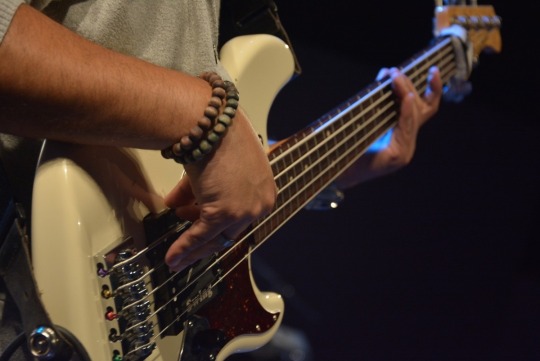#Musical Innovation
Explore tagged Tumblr posts
Text

Dear Friends,
On November 29th-30th, the Aggregate, Electroacoustic Music Festival will take place in Berlin. This event merges tradition with electronic music, as through the use of MIDI, artists metaphorically awaken the spirit of the machine slumbering within the organ. Therefore, the festival features artists deeply connected to movements such as algorave—a type of event where the artist writes code in real-time, generating music—and electroacoustic traditions.
The festival’s approach to the relationship between musician and instrument is retro-futuristic, drawing from the ideas of electroacoustic avant-garde figures like Kotoński, Schaeffer, Varèse, Stockhausen, and many others. However, it raises new questions about how computer-controlled instrumental music, with its virtuosity, transcends the boundaries of perception in highly compressed musical events. It explores the intersections between electronic and acoustic music, objective interpretation, and the effects of mechanically precise performance.
Curators: gamut inc
Check the events: https://de.ra.co/events/1993705
#Electroacoustic#Music Festival#Berlin Events#Algorave#LiveCoding#MIDI#RetroFuturistic#AvantGarde Music#ElectroacousticTradition#Electronic Music#Organ Music#Sound Art#Virtual Virtuosity#Experimental Music#Music Technology#Aggregate Festival#GamutInc#RealTimeCoding#Musical Innovation#New Music#berlin
7 notes
·
View notes
Text
Artificial Intelligence Revolutionizes the Music World: The Case of "Neural Notes Revolution"
Artificial intelligence (AI) is rapidly transforming our world, permeating sectors from healthcare to industry, education to transportation. This technology, which aims to replicate and surpass human cognitive abilities, promises to revolutionize the way we live and work.
The applications of AI are numerous and ever-expanding: from medical diagnosis to autonomous driving, data analysis to content creation. A particularly intriguing field is music, where AI is demonstrating remarkable potential.
Recently, there has been much discussion about AI-based music generation platforms like "Suno" and "Udio," accused of violating numerous artists' copyrights to train their algorithms. These controversies highlight the complex ethical and legal issues that AI raises in the artistic field.
In this context, the Italian project "Neural Notes Revolution" emerges, demonstrating how, with the aid of AI programs, the study of algorithms suitable for targeted generation of musical styles, voices, song structures, and with adequate post-processing, it's possible to produce musical pieces of any genre and style, in any language, in relatively short timeframes.
The project also leverages other generative AI platforms such as OpenAI's ChatGPT (Microsoft group, of which Elon Musk was a co-founder), Anthropic's Claude AI, and Google's Gemini. These technologies allow for the generation of texts, both original and based on precise or imaginative prompts, in numerous languages, even using expressions typical of specific localities and dialects.
However, "Neural Notes Revolution" still faces some challenges. The results provided by ChatBOTs require careful verification, and in the music field, generation platforms have significant limitations. In particular, "Suno" and "Udio" lack a precise and rigorous syntax that allows for accurate results. Often, the outcomes are even opposite to those desired, forcing a trial-and-error approach. One of the major limitations is the near-total impossibility of having clear style changes within the same song.
Expected future developments include the ability to modify produced songs in a targeted manner. It would be useful to have separate files for the vocal part, the musical backing, and the lyrics in subtitle format. Moreover, there's hope to be able to modify individual parts of text or music, and above all, to have a correct and rigorously respected syntax for the song structure and use of styles.
The use of these platforms raises several issues. On one hand, they offer new creative possibilities and democratize music production. On the other, they raise concerns about copyright, artistic authenticity, and the future of work in the music industry.
In conclusion, while giving space to creativity, we are still far from competing with the styles, voices, and tones of artists of all time. However, in defense of the "new artists" of the AI era, it must be recognized that creativity and skill are still necessary to produce musical pieces of a certain depth. This is particularly relevant in a modern musical landscape that often offers music devoid of artistic and cultural significance. AI in music thus represents both a challenge and an opportunity, requiring a balance between technological innovation and preservation of human artistic expression.
#neuralnotesrevolution#ai#Artificial Intelligence#AI and Music#AI Music Generation#AI-Generated Music#Musical Algorithms#Digital Music#Musical Innovation#Music Technology#Automated Composition#Artificial Creativity#AI Music Production#Future Music#AI in Music#Music and Technology#AI Musical Instruments#AI-Assisted Composition#AI Music Software#Neural Networks and Music#AI in Music Industry#AI Music Innovations
3 notes
·
View notes
Text
Original Smith Bros Dirty Martini (Instrumental Remix) - New Release from THISISGRAEME Music
Original Smith Bros Dirty Martini (Instrumental Remix) I’m excited to share with you a remix of one of my creations from a while back, Original Smith Bros Dirty Martini (Instrumental Remix)! It’s an instrumental drum and bass track that I’ve poured my heart and soul into, and I hope you enjoy it as much as I enjoyed making it. If you have enjoyed my music and would like to show your support,…

View On WordPress
#Album Project#Ambient Masterpiece#Artist Growth#creative process#Dirty Martini Remix#drum and bass#electronic music#hero&039;s journey#independent artist#instrumental music#music journey#music production#Musical Innovation#Musical Storytelling#New Music Release#New Zealand Artist#Soundscapes#Spotify Releases#THISISGRAEME Music#YouTube Music
3 notes
·
View notes
Text
This is from Scotty and Craig. This may be where they have painted their masterpiece. This is just part 1.
With all due respect given to Norbut Putnam, he was incorrect. Words matter; they have consequences. Before speaking, know what you're talking about first. 3 more parts are coming.
youtube
0 notes
Text
Exploring the Evolution of Music: A Deep Dive into Genre Fusion and Micro-Niche Trends
The music landscape has undergone a fascinating transformation in recent years, characterized by a surge in genre fusion and the emergence of micro-niches. This evolution reflects artists’ innovative approaches to creating music and the changing preferences of listeners worldwide. Let’s delve into this phenomenon and its impact on the music industry. The Era of Genre Fusion: A Dynamic Shift in…

View On WordPress
#Genre fusion#hip-hop#micro-niches#music#music community#music discovery#music evolution#music exploration#music trends#musical creativity#musical innovation#new-music
1 note
·
View note
Text


Lady Gaga accepting her Innovator Award at the 2025 iHeartRadio Music Awards in Los Angeles, California, on March 17th 2025
“On the one hand, I feel like I’ve been doing this forever. On the other hand, I know I’m just getting started. Even though the world might consider a woman in her late 30s old for a pop star — which is insane — I promise that I’m just getting warmed up.”
#lady gaga#mayhem era#2025#video#iHeartRadio Music Awards#iHeartRadio Music Awards 2025#iHeartRadio#ladygaga#gaga#lady-gaga#mother monster#mothermonster#iHeartAwards2025#Innovator Award#Innovator Award 2025#california#los angeles#gif#gaga gif#lady gaga gif
2K notes
·
View notes
Text
ABACUSYNTH by ELIAS JARZOMBEK [2022]
Abacusynth is a synthesizer inspired by an abacus, the ancient counting tool used all around the world. Just like an abacus is used to learn the fundamentals of math, the Abacusynth can be used to explore the building blocks of audio synthesis.
#elias jarzombek#abacusynth#technology#instruments#synthesizer#innovation#abacus#contemporary art#music#video#u
11K notes
·
View notes
Text
My Top 5 Old School Bass Players
Rock and roll is known for its fast-paced, electrifying guitar riffs and soulful vocals, but the bass guitar is an integral part of the genre. The bass guitar provides the foundation for the music, holding down the rhythm and adding depth and groove to the sound. Here are my picks for the top 5 old school rock and roll bass players: John Paul Jones – As the bassist for Led Zeppelin, John Paul…

View On WordPress
#Bass Players#Groove and Rhythm#Iconic Sound#Music Legacy#Music Legends#Musical Influences#Musical Innovation#Rock and Roll#Rock Music History#Top Bassists
0 notes
Text
survey for my research project
hey guys!
for ap research, my topic is about arts education in different cultures, as well as how people's environment impacts their views on the arts in the long run. i'm also conducting virtual interviews for anyone willing to volunteer (directions are in the survey)
here's the link to the survey: https://docs.google.com/forms/d/e/1FAIpQLSeIQOn5K-mXzNyyPHQ_x2QW02TKhwu5ghqknYvsnBiek5WXaw/viewform
#ap research#ap classes#research#art#arts education#writing#dancing#dance#artists#actors#surveys#google forms#culture#innovation#tradition#traditional art#painting#art history#singers#musician#music
344 notes
·
View notes
Text
Carly Rae Jepsen rly is the perfect pop star to me.
I know almost nothing about her personal life besides sweet anecdotes like her failed attempt to quit sugar and her engagement. And it’s exceedingly hard to know much more than that because she doesn’t do much press and her music is mostly just vaguely personal but largely just universal and broad.
Her music caters to that perfectly—it’s pop but constantly evolving. Covers a wide emotional spectrum but never goes too deep, aware of exactly what it’s meant to be. It’s a treat, it’s a bop, it’s pop! Her music ages with her but doesn’t age, if that makes sense. It has youth but isn’t juvenile. The music comes out regularly, with great and full b sides that justify their existence and don’t feel of chart manipulation or attempts to stay relevant.
She performs energetically on stage, does good crowd work, plays along with some fan stuff (blow up swords, the gays, the wig guy) without leaning too much into it, and she’s great about touring regularly at reasonable venues (not booking too large or two small). When my show got canceled due to weather, she performed a free show at a bar that night, AND rescheduled a free, full show the next after noon.
And she does all of this balancing to be the perfect level of famous—decent sized, loyal fandom that isn’t obsessive but will go to shows and buy her music—without coming off as manufactured or withholding. Like she feels like The Girl Next Door without it seeming forced, pathetic, or without it getting in the way of putting on a spectacular show either.
She’s accessible. But can’t be accessed.
I love it.
#carly rae jepsen#her music is soo good#like it’s so polished and fun#it’s not innovative but it’s never trend chasing either#it’s just… firmly in its wheelhouse#playing in its wheelhouse and flirting with other concepts but never leaving#can you telli listened to her for an hour or two last night lol#STILL THINKING ABOUT HERRR#HTE MUSIC IS SO GOOD
374 notes
·
View notes
Text
The Philosophy of Punk
The philosophy of punk is a distinctive blend of cultural rebellion, DIY ethos, and anti-establishment attitudes. Emerging from the punk rock music scene in the 1970s, punk philosophy has since evolved into a broader subcultural movement that encompasses music, fashion, art, and social commentary. Here's an exploration of the core tenets and influences of punk philosophy:
1. DIY Ethic
At the heart of punk philosophy is the "Do It Yourself" (DIY) ethic. Punk advocates self-sufficiency and creativity without reliance on mainstream institutions or commercial interests. This ethos encourages individuals to create their own music, art, and fashion, often using limited resources. It fosters a sense of empowerment and community, as punks produce and distribute their own records, zines, and merchandise.
2. Anti-Establishment and Rebellion
Punk philosophy is deeply rooted in anti-establishment sentiments. It rejects conventional norms, authority, and societal expectations. Punk often criticizes political systems, corporate greed, and social inequalities. This rebellious stance is reflected in the raw and confrontational style of punk music and the provocative nature of punk fashion, which frequently includes ripped clothing, bold hairstyles, and symbolic accessories like safety pins and leather jackets.
3. Individualism and Authenticity
Punk values individualism and authenticity, championing the idea of being true to oneself. It opposes conformity and encourages people to express their unique identities and beliefs. This focus on personal authenticity often translates into a rejection of polished, commercialized aesthetics in favor of raw, unfiltered expression.
4. Anarchy and Libertarianism
Many punk subcultures are influenced by anarchist and libertarian ideologies. Punk philosophy often promotes the idea of a society without hierarchical structures or authoritarian control. Anarcho-punk, a subgenre of punk, explicitly incorporates anarchist principles, advocating for direct action, mutual aid, and community-based alternatives to state power.
5. Social and Political Activism
Punk philosophy is not only about music and fashion but also about activism and social change. Punk bands and communities frequently address issues such as anti-racism, gender equality, LGBTQ+ rights, and environmentalism. Punk's activist spirit is evident in its support for grassroots movements, protests, and various forms of direct action.
6. Cultural Innovation and Subversion
Punk is known for its cultural innovation and subversion. It challenges mainstream cultural standards and pushes the boundaries of artistic expression. Punk art, music, and literature often employ satire, irony, and shock value to critique societal norms and provoke thought.
The philosophy of punk is a multifaceted and dynamic ideology that encompasses a wide range of attitudes and practices. At its core, punk is about rejecting conformity, embracing individuality, and striving for authenticity. It promotes a DIY ethic, challenges authority, and seeks to create a more just and equitable society through activism and direct action. Punk's enduring influence can be seen in various cultural and social movements, making it a vital and vibrant part of contemporary philosophy and culture.
#philosophy#epistemology#knowledge#learning#education#chatgpt#Philosophy Of Punk#Punk Ethos#DIY Culture#AntiEstablishment#Rebellion#Individualism#Authenticity#Anarchism#Libertarianism#Social Activism#Cultural Innovation#Punk Fashion#Punk Music#Grassroots Movements#Subcultural Philosophy
155 notes
·
View notes
Text

106 notes
·
View notes
Text
Pony & The Kid by Korey Dane from the album Youngblood
#music#korey dane#innovative leisure records#innovative leisure#tony berg#because music#hanni el khatib#patrick warren#marshall vore#daniel rhine#armand hirsch#bob ludwig#tchad blake#greg leisz#aaron embry#brandon duncan#artwork#joshua makela#Bandcamp
42 notes
·
View notes
Text

📸wsj
#charli xcx#wsj#wsj magazine#2024 music innovators#brat summer#charli xcx brat#indie sleaze#grunge#tumblr girls#soft grunge#pale grunge#indie sleaze revival
105 notes
·
View notes
Text



Lady Gaga accepting her Innovator Award at the 2025 iHeartRadio Music Awards in Los Angeles, California, on March 17th 2025
“I wouldn’t be here without my inspirations: David Bowie, Grace Jones, Carole King, Elton John, Lady Starlight, Madonna, Stevie Wonder, Duke Ellington, Cher, and of course, my dear friend, Tony Bennett who taught me to embrace the classics but never be bound by them.
Thank you to my Little Monsters. Thank you for always seeing me so clearly from The Fame to Mayhem. Because you saw me, I learned to see myself.
To the LGBTQ+ community, you taught me bravery before the world was able to listen. You have changed the world for the better, and your courage fuels mine every single day.”
#lady gaga#mayhem era#2025#video#iHeartRadio Music Awards#iHeartRadio Music Awards 2025#iHeartRadio#ladygaga#gaga#lady-gaga#mother monster#mothermonster#iHeartAwards2025#Innovator Award#Innovator Award 2025#california#los angeles#gif#gaga gif#lady gaga gif#lgbt#lgbt+#lgbtq#lgbtq+#lgbtqia#lgbtqia+#queer#transgender#trans#bisexual
819 notes
·
View notes
Text

SOUND BURGER [AT770] PORTABLE TURNTABLE AUDIO-TECHNICA OF JAPAN, 1983 | + INT. 2022
#advertising#retro tech#vinyl records#japanese#80s#audio-technica#sound burger#turntable#innovation#vintage advertising#music#technology#u
90 notes
·
View notes